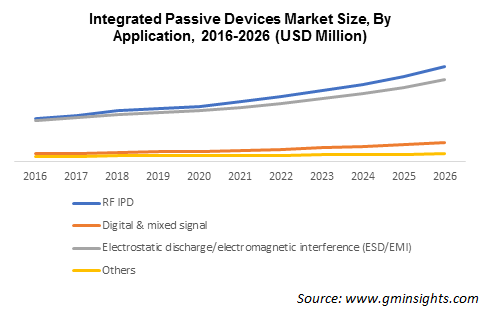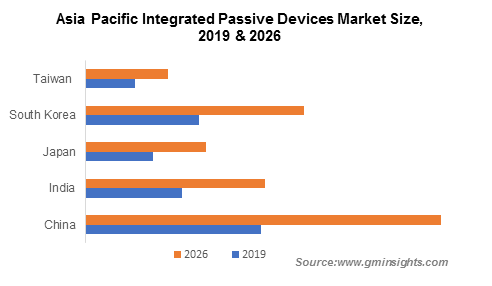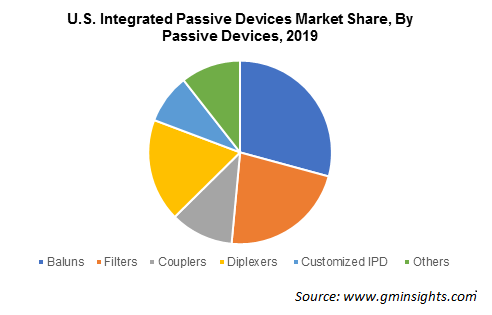Home > Semiconductors & Electronics > IC > Integrated Passive Devices Market
Integrated Passive Devices Market Analysis
- Report ID: GMI4124
- Published Date: Nov 2020
- Report Format: PDF
Integrated Passive Devices Market Analysis
In 2019, the silicon-based integrated passive devices market dominated over 75% revenue share and is projected to witness growth of around 9% through 2026. Silicon-based IPDs offer high insulation, small thermal coefficient, and improved device performance. The performance of IPD can be further improved with the integration of thick metal and dielectric layer to achieve high capacitance density in comparison with typical IC technology. The silicon-based integrated passive devices can be grinded to 100 micrometer thickness through several packaging options such as wire bonding, micro bumping, and copper pads.
The integrated passive devices market players are adopting several new techniques with silicon materials to enhance the IPDs performance. For example, the integration of 3D passive components into silicon helps integrated passive device manufacturers to deliver high density capacitor, Zener diode, and high-Q inductor in a single silicon die. The designing time of integrated passive devices on silicon depends upon the complexity of circuit, which can be reduced by using application-specific design tools and circuits.
The baluns segment held around 30% integrated passive devices market share in 2019 and is expected to register 10% growth rate till 2026. The market growth is majorly driven with the rising adoption of baluns in antenna systems such as broadcast, radio communication, among others. These devices offer a cost-effective cabling structure with long-distance transmission, accelerating their integration with various data and powerline communications for automotive, smart home, and other applications.
The proliferation of smart home and connected devices in the developing nations will impel the demand for baluns in the integrated passive devices market. According to GSMA, there will be approximately 13 billion new IoT connections around the globe in 2025, majorly driven by smart home and smart building verticals. The smart home vertical will encounter around two billion new connections. To cater to the high demand in the market, the companies are continuously innovating new products.

The digital & mixed signal segment in the integrated passive devices market will expand at a CAGR of around 11% during the forecast period propelled by the rising demand for implantable electronics and digital and mixed signal ICs in the medical sector. Integrated passive devices offer low power, small size, and high performance for various medical monitoring systems, including ECG, pulse oximetry, and blood analysis, which require precise analog for digital conversion.
The increasing demand for portable equipment in the medical sector will further boost the opportunities for integrated passive device manufacturers to deliver small footprint and low-power devices. The industry players are continuously developing new products and accelerating their innovation capabilities to gain a highly competitive edge over other players.
The consumer electronics segment is anticipated to grow at 10% CAGR during 2020-2026. The growth is attributed to increasing adoption of these components in various consumer electronics devices such as smartphones, laptops, tablets, wearables, among others. The integrated passive devices offer several high-end features, such as low power consumption, high chip connectivity, and smaller footprint, fueling their adoption in miniaturized hand-held gadgets.
Increasing innovations in advanced packaging technology led several device manufacturers to produce high-performance compact-sized integrated passive devices to serve the growing smartphone industry. For instance, in May 2020, TSMC announced the launch of wafer-level integrated passive device technology. Through this launch, the company aims to achieve high volume production of 5G terminal devices majorly smartphones for Apple. This will increase the adoption of IPD in consumer electronics devices.

Asia Pacific integrated passive devices market will witness a growth rate of over 10% from 2020 to 2026 led by supportive government initiatives toward expansion of semiconductor manufacturing in the region. For instance, in October 2020, the Ministry of Science and ICT, Government of South Korea announced to set an ambitious goal to develop 50 artificial intelligence (AI) semiconductor systems by 2030. The government also announced a funding of approximately USD 60.8 million to help local chip manufacturers in R&D activities to meet this ambitious objective. In addition, the country plans to become the AI leader in the coming years and has announced to spend approximately USD 843.9 million by 2029.

